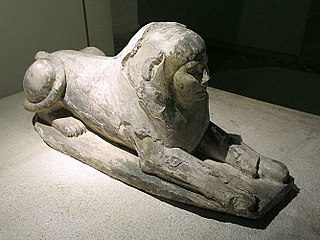
Khafra was an ancient Egyptian king (pharaoh) of the 4th dynasty during the Old Kingdom. He was the son of Khufu and the throne successor of Djedefre. According to the ancient historian Manetho, Khafra was followed by king Bikheris, but according to archaeological evidences he was rather followed by king Menkaure. Khafra was the builder of the second largest pyramid of Giza. The view held by modern Egyptology at large remains that the Great Sphinx was built in approximately 2500 BC for Khafra. There is not much known about Khafra, except the historical reports of Herodotus, writing 2,000 years after his life and who describes him as a cruel and heretic ruler, who kept the Egyptian temples closed after Khufu had sealed them.

Pepi II was a pharaoh of the Sixth Dynasty in Egypt's Old Kingdom who reigned from c. 2278 BC. His throne name, Neferkare (Nefer-ka-Re), means "Beautiful is the Ka of Re". He succeeded to the throne at age six, after the death of Merenre I.

Narmer was an ancient Egyptian king of the Early Dynastic Period. He probably was the successor to the Protodynastic king Ka, or possibly Scorpion. Some consider him the unifier of Egypt and founder of the First Dynasty, and in turn the first king of a unified Egypt.
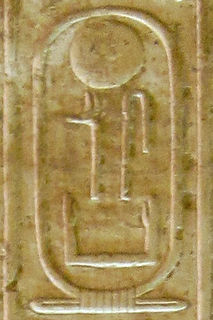
Userkare was the second pharaoh of the Sixth Dynasty, reigning briefly, 1 to 5 years, in the late 24th to early 23rd century BC. Userkare's relation to his predecessor Teti and successor Pepi I is unknown and his reign remains enigmatic. Although he is attested in historical sources, Userkare is completely absent from the tomb of the Egyptian officials who lived during his reign. In addition, the Egyptian priest Manetho reports that Userkare's predecessor Teti was murdered. Userkare is often considered to have been a short-lived usurper. Alternatively, he may have been a regent who ruled during Teti's son's childhood who later ascended the throne as Pepi I.
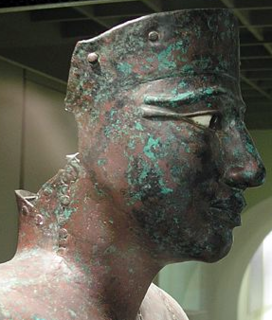
Pepi I Meryre was the third king of the Sixth dynasty of Egypt. His first throne name was Neferdjahor which the king later altered to Meryre meaning "beloved of Rê".

Merenre Nemtyemsaf I was the fourth king of the Sixth Dynasty of Egypt. His nomen, theophorically referring to Nemty, was formerly read as Antyemsaf, a reading now known to be incorrect.
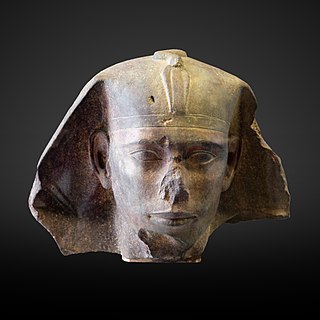
Djedefre was an ancient Egyptian king (pharaoh) of the 4th dynasty during the Old Kingdom. He is well known under his Hellenized name form Ratoises. Djedefre was the son and immediate throne successor of Khufu, the builder of the Great Pyramid of Giza; his mother is not known for certain. He was the king who introduced the royal title Sa-Rê and the first to connect his cartouche name with the sun god Ra.
The Eighth Dynasty of ancient Egypt is a poorly known and short-lived line of pharaohs reigning in rapid succession in the early 22nd century BC, likely with their seat of power in Memphis. The Eighth Dynasty held sway at a time referred to as the very end of the Old Kingdom or the beginning of the First Intermediate Period. The power of the pharaohs was waning while that of the provincial governors, known as nomarchs, was very important, the Egyptian state having by then effectively turned into a feudal system. In spite of close relations between the Memphite kings and powerful nomarchs, notably in Coptos, the Eighth Dynasty was eventually overthrown by the nomarchs of Heracleopolis Magna, who founded the Ninth Dynasty. The Eighth Dynasty is sometimes combined with the preceding Seventh Dynasty, owing to the lack of archeological evidence for the latter which may be fictitious.

Hor-Aha is considered the second pharaoh of the First Dynasty of Egypt by some Egyptologists, others consider him the first one and corresponding to Menes. He lived around the 31st century BC and is thought to have had a long reign.

Nynetjer is the Horus name of the third pharaoh of the Second Dynasty of Egypt. The length of his reign is unknown. The Turin Canon suggests an improbable reign of 96 years and Egyptian historian Manetho suggested that Nynetjer's reign lasted 47 years. Egyptologists question both statements as misinterpretations or exaggerations. They generally credit Nynetjer with a reign of either 43 years or 45 years. Their estimation is based on the reconstructions of the well known Palermo Stone inscription reporting the years 7–21, the Cairo Stone inscription reporting the years 36–44. According to different authors, Nynetjer ruled Egypt from c. 2850 BC to 2760 BC or later from c. 2760 BC to 2715 BC.

Den, also known as Hor-Den, Dewen and Udimu, is the Horus name of a pharaoh of the Early Dynastic Period who ruled during the First Dynasty of Egypt. He is the best archaeologically-attested ruler of this period. Den is said to have brought prosperity to his realm and numerous innovations are attributed to his reign. He was the first to use the title "King of Lower and Upper Egypt", and the first depicted as wearing the double crown. The floor of his tomb at Umm El Qa'ab near Abydos is made of red and black granite, the first time in Egypt this hard stone was used as a building material. During his long reign he established many of the patterns of court ritual and royalty used by later rulers and he was held in high regard by his immediate successors.

Nebra or Raneb is the Horus name of the second early Egyptian king of the 2nd dynasty. The exact length of his reign is unknown since the Turin canon is damaged and the year accounts are lost. The ancient Greek historian Manetho suggests that Nebra's reign lasted 39 years, but Egyptologists question Manetho's view as a misinterpretation or exaggeration of information that was available to him. They credit Nebra with either a 10- or 14-year rule. According to different authors, Nebra ruled Egypt c. 2850 BC, from 2820 BC to 2790 BC, 2800 BC to 2785 BC or 2765 BC to 2750 BC.

The South Saqqara Stone is the lid of the sarcophagus of the ancient Egyptian queen Ankhenespepi which was inscribed with a list for the reigns of the pharaohs of the 6th dynasty from Teti, Userkare, Pepi I, Merenre to the early years of Pepi II under whom the document was likely created. It is essentially an annal document which records events in each year of a king's reign; unfortunately, it was reused in antiquity for Ankhesenpepi I's burial and many of its invaluable inscriptions have been erased.
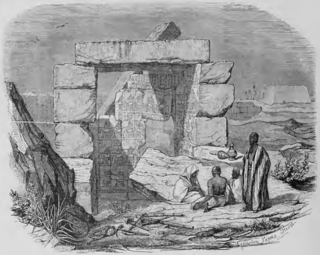
The Karnak king list, a list of early Egyptian kings engraved in stone, was located in the southwest corner of the Festival Hall of Thutmose III, in the middle of the Precinct of Amun-Re, in the Karnak Temple Complex, in modern Luxor, Egypt. Composed during the reign of Thutmose III, it listed sixty-one kings beginning with Sneferu from Egypt's Old Kingdom. Only the names of thirty-nine kings are still legible, and one is not written in a cartouche.

Sneferu, well known under his Hellenized name Soris, was the founding pharaoh of the Fourth Dynasty of Egypt during the Old Kingdom. Estimates of his reign vary, with for instance The Oxford History of Ancient Egypt suggesting a reign from around 2613 to 2589 BCE, a reign of 24 years, while Rolf Krauss suggests a 30-year reign, and Rainer Stadelmann a 48-year reign. He built at least three pyramids that survive to this day and introduced major innovations in the design and construction of pyramids.
Nubnefer is the birth name of a king (pharaoh) who may have ruled during the 2nd dynasty of Ancient Egypt. The exact length of his reign is unknown and his chronological position is unclear.

Bikheris is the Hellenized name of an Ancient Egyptian pharaoh, who may have ruled during the 4th Dynasty around 2570 BC. Next to nothing is known about this ruler and some Egyptologists even believe him to be fictitious.
A coronation was an extremely important ritual in early and ancient Egyptian history, concerning the change of power and rulership between two succeeding pharaohs. The accession to the throne was celebrated in several ceremonies, rites and feasts.

The Inventory Stela is an Ancient Egyptian commemorative tablet dating to the 26th Dynasty. It was found in Giza during the 19th century. The stela presents a list of 22 divine statues owned by a Temple of Isis, and goes on to claim that the temple existed since before the time of Khufu.








